This sourdough sandwich bread recipe makes an amazingly super-soft bread with a flavor and texture that kids absolutely love. Once you make this easy no-knead sourdough bread, buying it from the store will be a thing of the past!
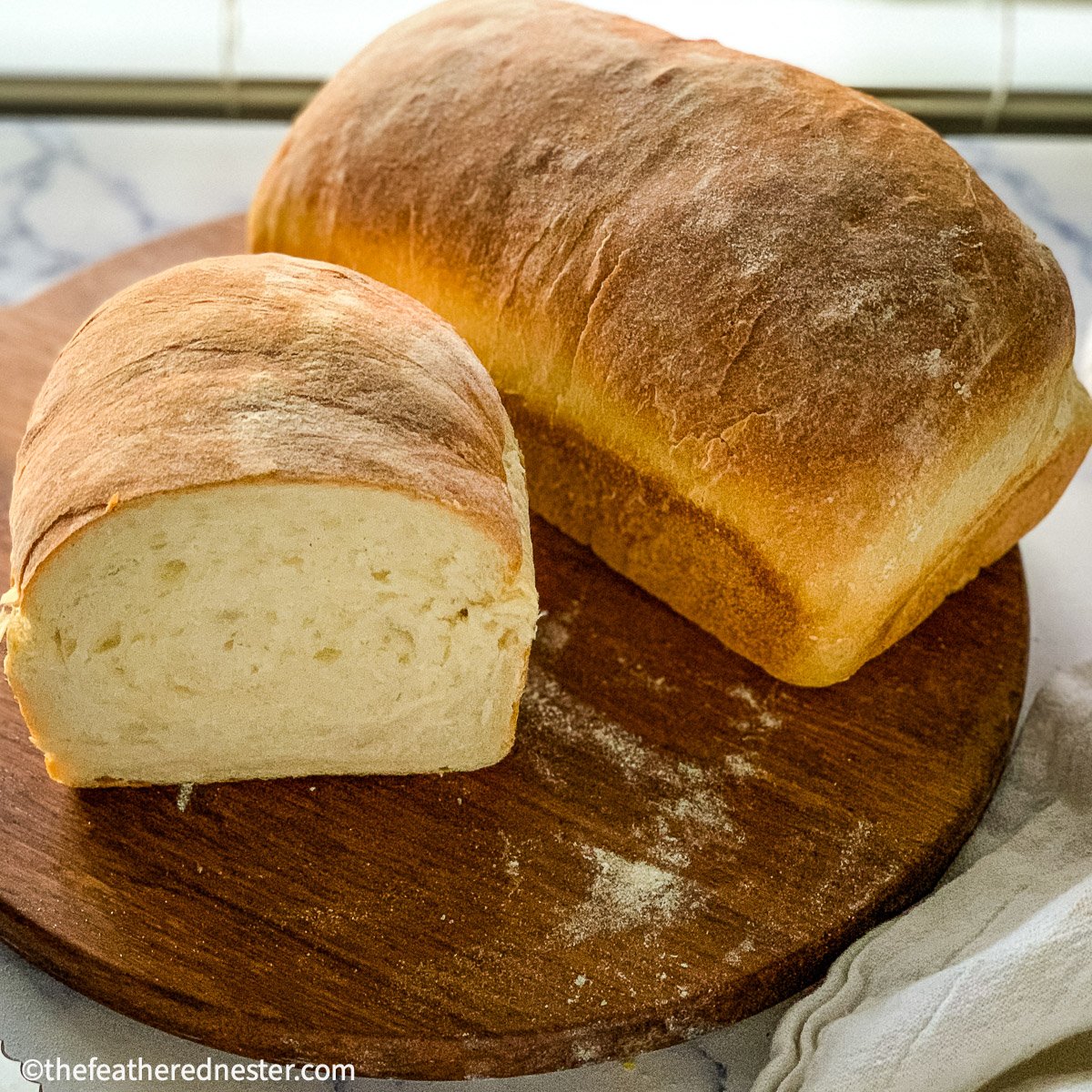
Content Covered Here
Sourdough Sandwich Bread Video Tutorial
Why We Love This Sourdough Sandwich Bread Recipe
- It’s super soft inside and out – so everyone loves it!
Sourdough loaves typically have a sour taste and crunchy, chewy exterior that some people (and kids) dislike. However, this recipe is baked in a loaf pan for a wonderfully light crust and soft interior. - There is no kneading required!
Since this is a no-knead bread recipe, there’s no worry about “Have I kneaded the dough enough?” The recipe is literally fail-proof. - It tastes like “regular” sandwich bread – without the “sour” taste.
Even if your kids aren’t sourdough fans, they’ll love it! They probably won’t even notice the difference between it and store-bought. The kids might also like our grilled cheese on sourdough bread recipe or our sourdough breakfast sandwich.
Learn more about how sourdough is fermented in my overnight sourdough bread post.
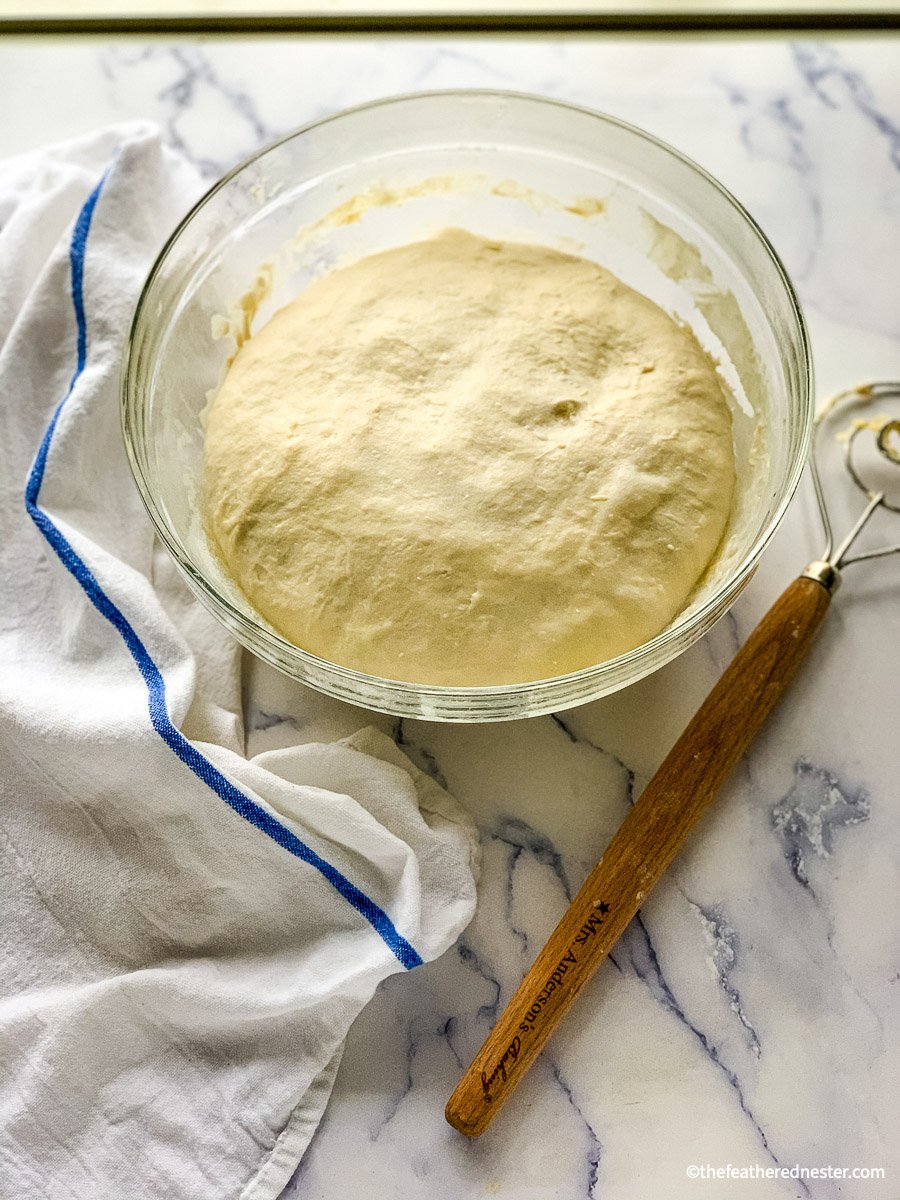
Ingredient Notes & Substitutions
Make this yummy soft loaf with just a handful of simple ingredients. There’s no yeast, eggs, or milk required!
- “Active” Sourdough starter – fed 12-24 hours before starting the recipe.
When we say “active,” we mean a mature starter that is at least a week old and always doubles in size within 4-6 hours of feeding. It doesn’t mean you need to use it at the peak activity after a feeding. This recipe uses an unfed starter or one that was fed 12-24 hours prior. - Bread flour – I prefer using unbleached King Arthur bread flour. Although you can use all-purpose flour, the higher protein content in bread flour creates a higher more airy loaf that’s perfect for sandwiches.
- Sugar – Granulated sugar or you can substitute the sugar with 2 rounded tablespoons of honey.
Do you lack a sourdough starter? My quick and easy sourdough starter recipe can make a fast starter in just five days. You can also make a loaf of our classic sandwich bread or whole wheat sandwich bread recipe, which uses yeast instead.
How to Make No Knead Sourdough Bread
This sourdough bread recipe requires just a few basic steps. Spoiler alert: the overnight rise makes a soft sandwich loaf that’s far better than anything you’ll find at the grocery store.
Start the recipe on a relaxing Saturday or Sunday evening, and then bake the next day. It will be ready to slice and stack with your favorite sandwich ingredients during the week.
🎯 TFN Pro Tip
I recommend using a clear glass mixing bowl. This allows you to see the activity on the dough’s top and bottom. Often, the bottom of the dough will show a lot of activity, reassuring you that it’s properly fermented.
Mix the dough
- First, feed your starter 12-24 hours before starting the recipe.
- In a medium bowl, combine the starter with warm water, and then add flour, sugar, oil, and salt. I like using a dough whisk for mixing. Mix well to form a shaggy, sticky dough.
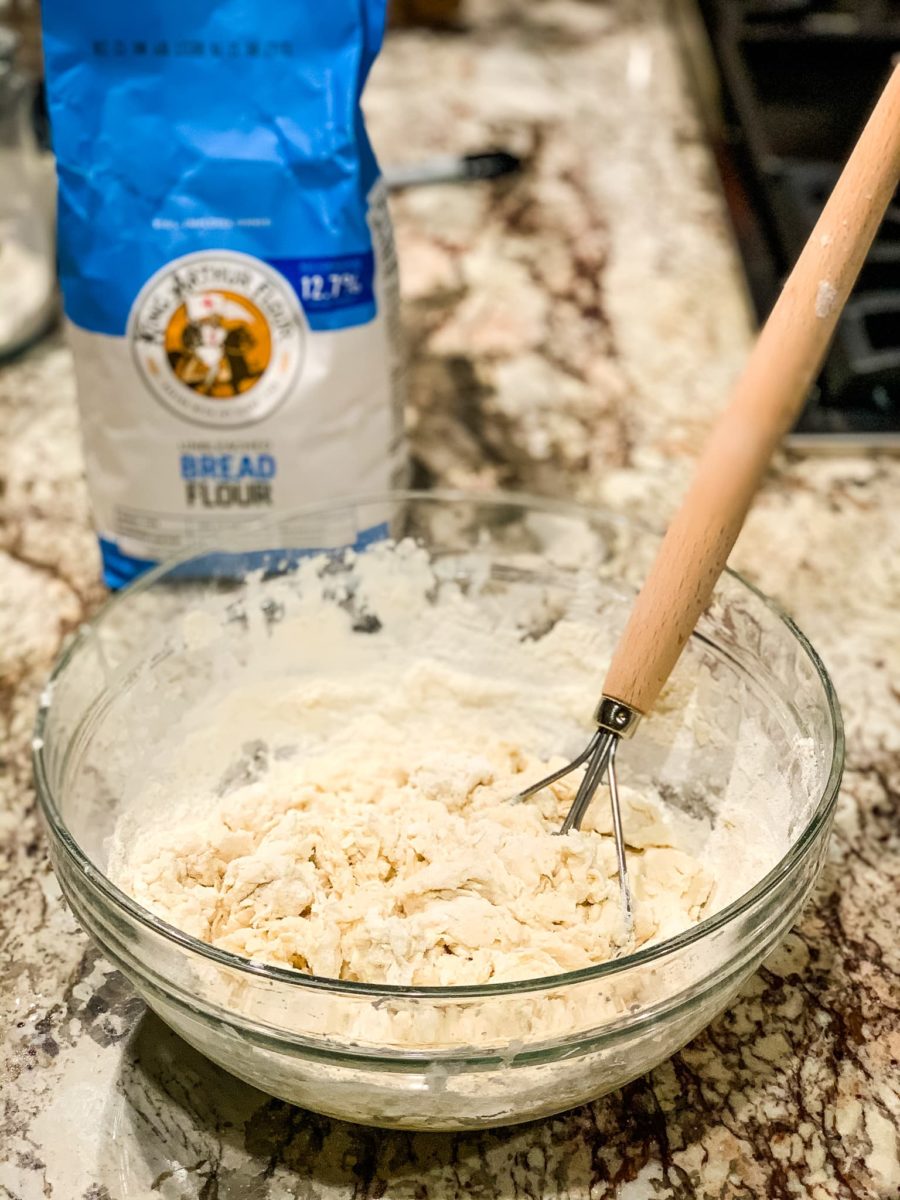
- Flour or wet your clean hands and use them to finishing mixing the dough. Then, cover the bowl with a damp towel and allow it to rise for 30-45 minutes.
- Coax the dough from the bowl, place it on a clean and lightly floured surface, then do a set of stretch and folds several times (see video below).
Overnight Sourdough Fermentation Process
The dough needs a long fermentation bulk rise, usually done overnight. This process is what rises the dough with wild yeast instead of commercial yeast. See our Fermentation Rising Guidelines in the recipe card for estimated rising times.
Looking for a shorter fermentation rise recipe to use up your sourdough discard? You’ll love our sourdough flatbread recipe! Use it for wraps, naan, or even pizza. Best of all, it only has a one hour rise so they’re ready fast!
🎯 TFN Pro Tip
Tips for keeping dough warm during colder months:
Place the bowl in the oven with the light on and the door slightly open to create a warmer climate without actually turning the oven on. Before doing this, make sure to take the temperature of your oven with the light on to ensure this method doesn’t get too hot! Or, do a bulk ferment during the day when you can monitor progress until you know how your dough responds to your specific environment.
Use a heated mat (like those used for germinating seeds) for rising. See my Sourdough Tools list to shop what I use.
Use the “proof” setting of your oven (I set mine to 85ºF) and set a timer. This will speed up the rising process, so check it at 4 and 6 hours.
If there is a sunny room in the house that stays warm, keep the dough covered in that area.
- Cover the bowl with a damp towel and leave the sourdough to rise at room temperature overnight, approximately 8-10 hours (see recipe for a sourdough rise chart). If you live in a drier climate then I recommend covering the bowl with plastic wrap instead of a damp towel. The plastic wrap keeps the dough from drying out overnight.

- In the morning, lightly flour your countertop. Remove the dough from the bowl and roll up the dough into a log shape (as shown below). Cover with a damp towel and let the dough rest for about 10 minutes.
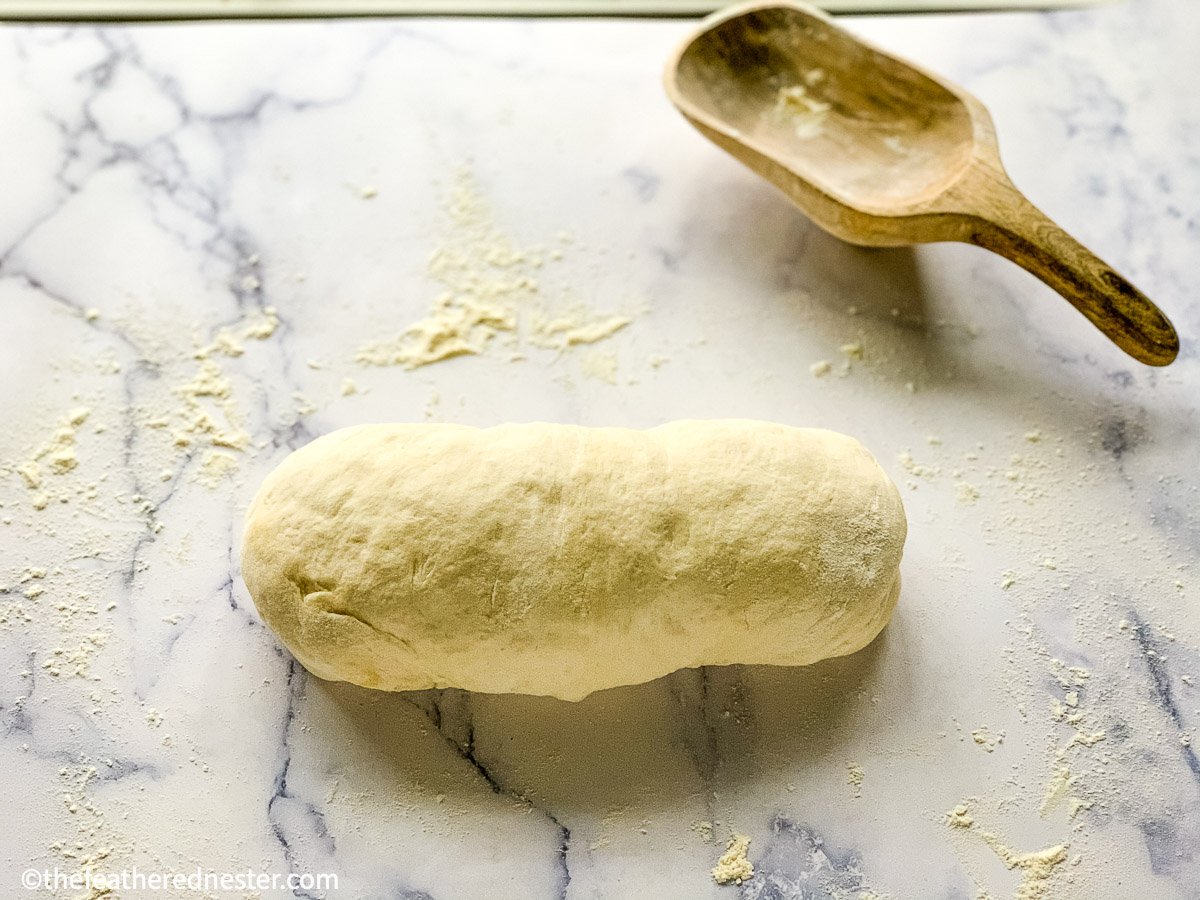
Baking Instructions
- Lightly spray a 9” x 5” loaf pan with nonstick spray. Then tighten the loaf by gently rolling and pulling the dough, and transfer it to the prepared loaf pan seam side down.
Cover with a towel and let the loaf rise for another hour or two.
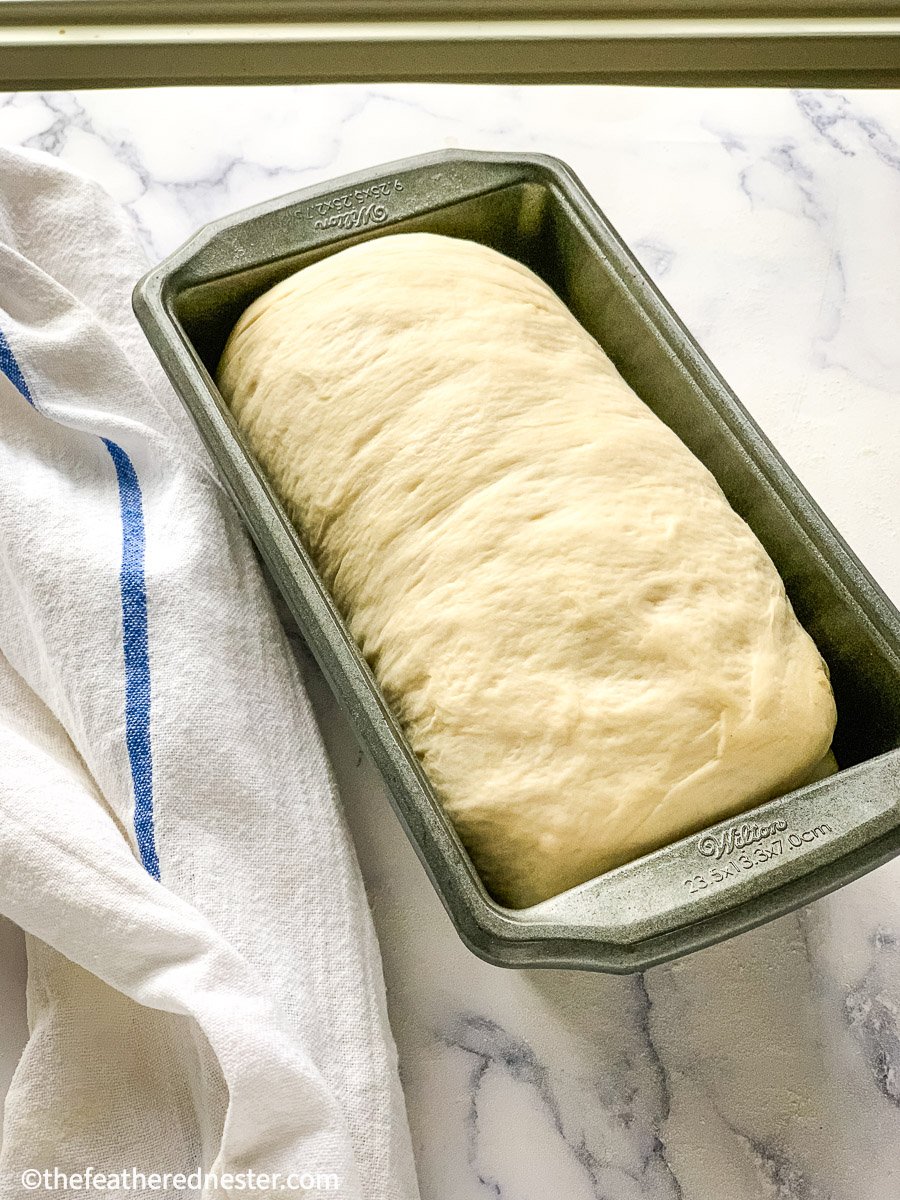
- When you’re ready to bake your loaf, preheat the oven to 375ºF. Then bake for 40 minutes, until the crust is a lovely golden brown color.
Remove the pan from the oven and allow it to rest for 10 minutes before carefully tipping it out of the pan onto a wire rack to cool.
Let the sourdough cool for at least one hour before storing it whole or sliced and enjoyed.
Serving Suggestion
This sandwich bread is incredibly versatile. Elevate your breakfast with an avocado sandwich spread on toasted slices. For a more substantial meal, consider a classic BLT with crispy bacon, ripe tomatoes, and a drizzle of mayonnaise.
If you want to add flavor to your sandwich bread, you might want to try our sourdough cinnamon raisin bread!
Recipe FAQs
Yes, you can use all-purpose flour instead of bread flour, using the same amount of flour. Since all-purpose flour has a slightly lower protein content than bread flour, your loaf might be slightly smaller.
You can, but for the best texture (density) and softness, I recommend only replacing 1/2 of the all purpose flour with whole wheat flour.
The dough needs a warm area for the bulk (overnight) fermented rise. Find a warm place (75º – 85º F) like an oven with the light on, a warm window, or above the dryer to extend the bulk fermentation rise for 2 more hours.
When the baking time is up, I check to see if the top of the loaf is golden and it sounds hollow when tapped on. If you are unsure, check the internal temperature which should be around 195º – 200ºF.
Let the bread cool completely. Store it in a plastic bag at room temperature. I use a plastic bread bag with a twist tie to seal it and it stays fresh for about 5 days. For the softest crust, we recommend storing it out of the fridge at room temperature.
To keep it fresher longer, put it in an air tight, freezer safe container and keep it in the freezer for up to 3 months. Let it defrost at room temperature before slicing and using.
For more storage tips, see our post on how to store sourdough bread.
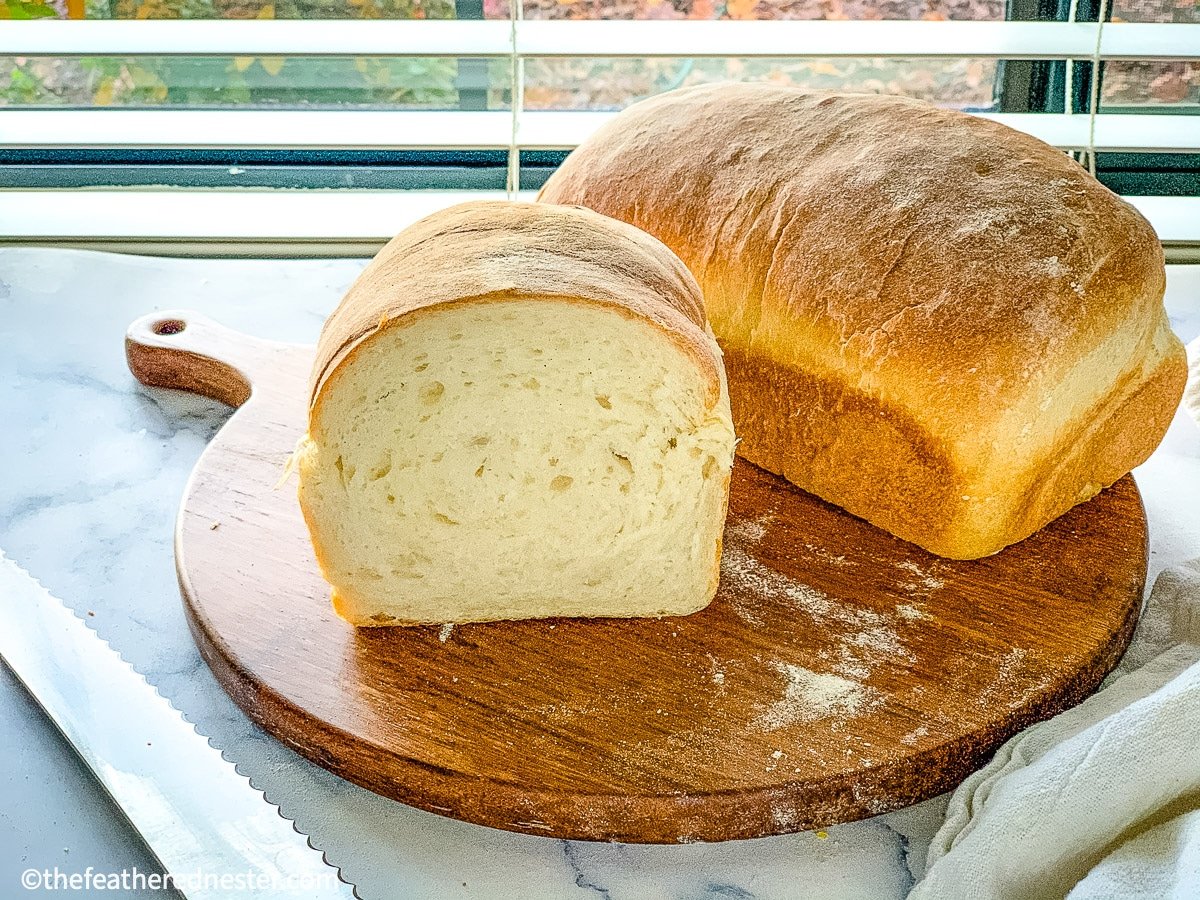
More Easy Sourdough Recipes…
- Double Chocolate Sourdough Bread
- Jalapeno Cheddar Sourdough Bread
- Sourdough Bread Bowls Recipe
- Sourdough Garlic Toast
If you tried this soft sourdough sandwich bread recipe or any other recipe on my website, please leave a 🌟 star rating and let me know how it went in the 📝 comments below. Thanks for visiting!

Sourdough Sandwich Bread
Equipment
- loaf pan - See notes for a 12' x 4.5" pan
- large bowl
- dough whisk
Ingredients
- ⅓ cup (65 grams) sourdough starter discard or fed 12-24 hours prior *see notes below
- 1⅓ cups (300 grams) warm water, filtered 95º to 100º F
- ¼ cup (56 grams) granulated sugar can substitute with 2 rounded tablespoons of honey
- 3½ -4 cups (500 grams) bread flour or all-purpose flour. I recommend weighing your flour, see notes for using measuring cups
- 1½ tablespoons (20 grams) extra-virgin olive oil
- 2 teaspoons (9 grams) salt
Instructions
- Add the starter to a large bowl. Mix in warm water and sugar, stirring until dissolved. Add flour, oil, and salt. Stir with a dough whisk or wooden spoon until a thick, shaggy dough forms.
- Flour your hands or wet your hands, and finish mixing dough by hand until most of the flour has been absorbed. Don't worry if there is flour on the sides or bottom of the bowl. Cover with a clean, damp kitchen towel and let the dough rest for 30 to 45 minutes.
- Coax the dough from the bowl and stretch and fold the dough by stretching 4 inches then pushing it down the middle and turning 1/4 until you make a circle (see video below for how to do this).Return the dough to the bowl, cover with a damp towel, and let rise at room temperature overnight (at least 8-10 hours) until double in size. Do not refrigerate dough.
- In the morning, lightly flour your counter top. Remove the dough from the bowl, gently stretching it into a rectangle, then your fingers to dimple the rough to release the air from the dough (as shown in photo). Roll up dough into a log shape. Cover and let the dough rest 10 minutes.
- Spray loaf pan with cooking spray. To bake smaller loaves, see Recipe Notes below for directions.Tighten the dough log by gently pulling it towards you along the countertop for 5-8". Place it in your loaf pan, seam side down. Cover and let rise for 1-2 hours, until the dough is about double in size.To see if it's ready to bake, press the corner edge of the dough in 1/2" and if the indentation remains, it's ready to bake.
- Preheat your oven to 375ºF. If desired, brush the top of the loaf with an egg wash.
- Bake in the center of the oven for 40 minutes. See Recipe Notes below for smaller loaves. The top of the loaf should be golden in color. Remove from oven.After 10 minutes, tilt the pan to remove the bread to cool on a cooling rack.
- Wait at least 1 hour before cutting (to prevent the loaf from deflating).
Video

Notes
- I recommend using a clear glass mixing bowl for fermentation. This allows you to see the activity on the dough’s top and bottom. Often, the bottom of the dough will show a lot of activity, reassuring you that it’s properly fermented.
- The recipe ingredients call for 3 1/2 to 4 cups of flour because cup measuring is less reliable than using a food scale to weigh the flour.
- Be sure to stir the flour, then use a spoon to add it into the measuring cup, and level it with a knife. Start with the lower amount of flour and add up to 4 cups, but only if needed.
- 80ºF about 4-5 hours
- 75ºF about 6-7 hours
- 70ºF about 8-9 hours
- For temperatures under 70ºF it can take up to 12 hours or more
- Place the bowl in the oven with the door closed and light on to create a slightly warmer climate without actually turning the oven on.
- Use a heated mat (like those used for germinating seeds) for rising.
- Use the “proof” setting of your oven (I set mine to 85ºF) and set a timer. This will speed up the rising process, so check it at 4 and 6 hours.
- If there is a sunny room in the house that stays warm, keep the dough covered in that area.
- Let the bread cool completely. Store it in a plastic bag at room temperature. I use a plastic bread bag with a twist tie to seal it and it stays fresh for about 5 days. For the softest crust, we recommend sorting it out of the fridge at room temperature.
- To keep it fresher longer, put it in an air tight, freezer safe container and keep it in the freezer for up to 3 months. Let it defrost at room temperature before slicing and using.
- For more storage tips, see our post on how to store sourdough bread.

Delilah stoltzfus says
Is it ok to make a double batch?
Renae says
Yes, you can make a double batch. Be sure to use two bread pans so that the rest of the recipe remains the same with baking times. Doubling the recipe should not change anything with the rise times.
Tracey says
This worked out perfectly. I’ve tried a lot of sourdough recipes with not as much success as this one. Thank you. I’ll be interested to try your other recipes.
Renae says
I love hearing this! My recipes have to be almost fail-proof to make it on the blog.
Devchenka says
I was excited to try this recipe as I got used to making sourdough bread. I used my active very bubbly starter and left it overnight to rise. When I woke up I did not see any progress at all. I’m wondering what I’ve done wrong. I almost thought to myself I should of put more starter in the recipe.
Renae says
If you have an active starter, you should not have to use more starter in this recipe. Most of the time when my dough does not look bubbly in the morning it is because the room where I left the bread rise was not warm enough (at least 75ºF). So, the dough will need longer to fully ferment for the bulk rise. This happens more in the winter and spring months.
SallysHubby says
Thank you for this recipe. I have been making sourdough bread for about 3 years, using another recipe. This one of yours produces a much softer bread with a less tough crust. The wife asks me to use your recipe from now on. I suspect the longer overnight rise time is what makes the difference because the only difference in recipe is the other one has no sugar.
Renae says
Thank you for letting me know. I’m so glad you enjoy one of my favorite recipes!
Laura says
I loved how this baked up and the texture is wonderfully soft. It was far too sweet for my taste and I wonder how much I can cut back on the sugar and not mess up the outcome. It’s very close to what I’m looking for because I’d just as soon retain the sourdough flavor profile but in soft sandwich loaf form.
Renae says
Sandwich bread is typically a little sweeter than artisan loaves (which have no sweetener). Also, the “sourness” of a sourdough starter can vary greatly between sourdough starters. So what comes out too sweet with your starter might not be as sweet with someone else’s sourdough starter. You can safely omit up to 1/2 of the sweetener in this recipe to make it more to your taste without compromising the recipe’s integrity.